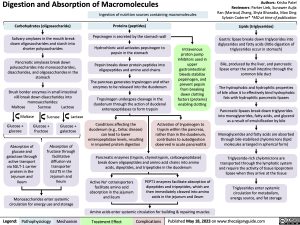Digestion and Absorption of Macromolecules
Authors: Krisha Patel Reviewers: Parker Lieb, Sunawer Aujla Ran (Marissa) Zhang, Shyla Bharadia, Mao Ding Sylvain Coderre* *MD at time of publication
Lipids (triglycerides)
Gastric lipase breaks down triglycerides into diglycerides and fatty acids (little digestion of triglycerides occur in stomach)
Bile, produced by the liver, and pancreatic lipase enter the small intestine through the common bile duct
The hydrophobic and hydrophilic properties of bile allow it to effectively bind hydrophobic fats with hydrophilic pancreatic lipases
Pancreatic lipases break down triglycerides into monoglycerides, fatty acids, and glycerol as a result of emulsification by bile
Monoglycerides and fatty acids are absorbed through bile-stabilized chylomicrons (lipid molecules arranged in spherical form)
Triglyceride-rich chylomicrons are transported through the lymphatic system and require the activity of tissue lipoprotein lipase when they arrive at the tissue
Triglycerides enter systemic circulation for metabolism, energy source, and fat storage
Ingestion of nutrition sources containing macromolecules
Carbohydrates (oligosaccharide)
Salivary amylases in the mouth break down oligosaccharides and starch into shorter polysaccharides
Pancreatic amylases break down polysaccharides into monosaccharides, disaccharides, and oligosaccharides in the stomach
Brush border enzymes in small intestinal villi break down disaccharides into
Proteins (peptides)
Pepsinogen is secreted by the stomach wall
Hydrochloric acid activates pepsinogen to pepsin in the stomach
Pepsin breaks down protein peptides into oligopeptides and amino acid chains
The pancreas generates trypsinogen and other enzymes to be released into the duodenum
Trypsinogen undergoes cleavage in the duodenum through the action of duodenal enteropeptidases to form trypsin
Intravenous proton pump inhibitors used in upper gastrointestinal bleeds stabilize pepsinogen, and prevent pepsin from breaking down clotting factors (proteins) enabling clotting
Maltose Maltase
monosaccharides: Sucrose
Sucrase
Glucose + fructose
Lactose Lactase
Glucose + galactose
Glucose + glucose
Conditions affecting the duodenum (e.g., Celiac disease) can lead to lower enteropeptidase levels, resulting in impaired protein digestion
Activation of trypsinogen to
trypsin within the pancreas, rather than in the duodenum, contributes to autodigestion observed in acute pancreatitis
Absorption of glucose and galactose through active transport via SGLT-1 carrier protein in the Jejunum and Ileum
Absorption of fructose through facilitative diffusion via transporter GLUT5 in the Jejunum and Ileum
Pancreatic enzymes (trypsin, chymotrypsin, carboxypeptidase) break down oligopeptides and amino acid chains into amino acids, dipeptides, and tripeptides in the duodenum
Monosaccharides enter systemic circulation for energy use and storage
Active Na+ cotransporters facilitate amino acid absorption in the jejunum and ileum
PEPT1 enzymes facilitate absorption of dipeptides and tripeptides, which are then immediately cleaved into amino acids in the jejunum and ileum
Amino acids enter systemic circulation for building & repairing muscles
Legend:
Pathophysiology
Mechanism
Treatment Effect
Complications
Published May 18, 2023 on www.thecalgaryguide.com
Foundations
Systems
Other Languages
Physiology Gastroenterology Digestion and Absorption of Macromolecules Digestion and Absorption of Macromolecules

